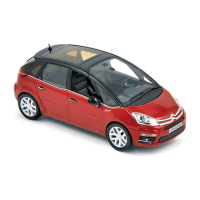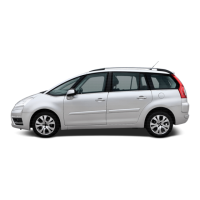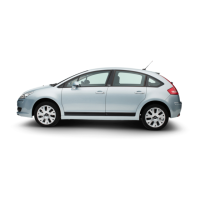Do you have a question about the CITROEN Grand C4 Picasso and is the answer not in the manual?
Details about external features, lighting, parking assistance, and keyless entry systems.
Information on vehicle access, including electronic key and central locking systems.
Details about interior features like the panoramic sunroof and touch screen tablet.
Guidance on adjusting seats, head restraints, and steering wheel for comfort.
Procedures for starting the engine, parking brake, and Stop & Start system.
Practices to optimize fuel consumption and CO2 emissions.
Explains basic navigation and operation of the touch screen tablet interface and its menus.
Details associated warnings, including audible signals and messages, accompanying indicator lamps.
Explains the various dials, screens, and indicators found in the type 1 instrument panel.
Details the dials, screens, and indicators presented on the type 2 instrument panel.
Explains how the service indicator alerts the driver about upcoming maintenance or overdue services.
Guides on checking the engine oil level using the dipstick and interpreting the marks.
Details how trip computer information is displayed on the touch screen tablet, including various tabs.
Step-by-step guide for starting and switching off the engine using the electronic key.
Explains the manual and automatic operation of the electric parking brake system.
Describes the hill start assist system that temporarily immobilizes the vehicle on gradients.
Details the gear selector lever positions (P, R, N, A, M) and their functions.
Details how the engine enters STOP mode automatically during traffic stops for fuel saving.
Describes the steering wheel controls for managing the speed limiter function.
Explains the steering wheel controls used for operating the cruise control system.
Details the principles of operation for the active cruise control system, including radar detection.
Guides on setting the alert thresholds for the collision risk system based on driving conditions.
Explains how the camera detects lane markings and alerts the driver to involuntary lane departures.
Describes the operation of blind spot sensors that detect vehicles in the driver's blind spots.
Details the function of front parking sensors, including their activation and interruption conditions.
Explains the reversing camera system that activates automatically in reverse gear.
Explains the Park Assist system for automated parking maneuvers, including parallel and bay parking.
Covers the selection and modes of main lighting, including dipped and main beam headlamps.
Explains automatic headlamp activation based on ambient light conditions and rain detection.
Describes the automatic headlamp dipping system that adjusts beams based on lighting and traffic.
Explains the manual and automatic operation of the windscreen wipers and their controls.
Explains the function of courtesy lamps for vehicle approach and location, with different lighting modes.
Describes the panoramic sunroof, including its electric blind and anti-pinch function.
Explains how to make an emergency or assistance call using the vehicle's built-in system.
Explains the tyre under-inflation detection system that monitors tyre pressures while driving.
Details the ESC system, including ABS, EBFD, emergency braking, ASR, and DSC.
Explains the features and proper use of front, rear, and third-row seat belts, including pretensioning.
Describes the airbag system, its deployment, and impact detection zones for occupant safety.
Offers general recommendations for child seat installation, safety, and advice on using them in the vehicle.
Explains the ISOFIX mounting system for fast, reliable, and safe installation of child seats.
Describes the manual child lock system that prevents rear door opening from the inside.
Details the location and access to the temporary puncture repair kit components.
Explains where to find the tools required for changing a wheel.
Provides advice on fitting and using snow chains, including tyre size compatibility and driving tips.
Details the procedures for changing bulbs in the front lamps, including xenon and halogen models.
Provides instructions on how to charge the vehicle's 12 V battery using a charger.
Offers general recommendations and legal observations for towing vehicles.
Details the fitting and conditions of use for transverse roof bars approved for the vehicle.
Lists available comfort accessories such as door deflectors, blinds, and lighting.
Explains the procedure for opening the vehicle bonnet, including safety precautions.
Details the location of caps and covers for checking fluids and components in petrol engines.
Explains access to engine fluids and components for diesel engines.
Guides on the refueling procedure, including fuel type selection and nozzle insertion.
Details the procedure for priming the fuel system on HDi engines if the vehicle runs out of diesel.
Guides on checking the engine oil level via the instrument panel or dipstick.
States that manual gearboxes do not require maintenance apart from level checks.
Notes that the electric parking brake does not require routine servicing but should be checked if problems occur.
Provides technical specifications for petrol engines and their associated gearboxes.
Lists the vehicle's dimensions in millimeters, measured on an unloaded or unladen vehicle.
Details the location of visible markings for vehicle identification, including VIN and manufacturer labels.
Explains how to make an emergency call using the vehicle's system and the green LED indicator.
Guides on how to request roadside assistance for vehicle breakdowns using the dedicated button.
Explains basic navigation and operation of the touch screen tablet interface and its menus.
Explains how to adjust audio volume for different sources, including traffic announcements.
Details the functions of various buttons integrated into the steering wheel for audio, phone, and cruise control.
Describes how to select audio sources like radio, MP3, and manage playback.
Introduces the primary interface of the navigation system.
Details the steps for entering a new destination, including address, GPS coordinates, and points of interest.
Describes how to access traffic information and set filters for messages and radius.
Explains map settings, including orientation, colour schemes, and display modes.
Covers settings for audio, colour schemes, system preferences, and interactive help.
Details how to connect and manage mobile phones via Bluetooth for hands-free calls and audio streaming.
Addresses frequent questions regarding route calculation, POI display, and audible warnings.
| Brand | CITROEN |
|---|---|
| Model | Grand C4 Picasso |
| Category | Automobile |
| Language | English |











